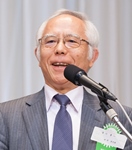Reading the Times through Celebrities (Japanese Idols)
November 18, 2015
Prof. Koichi Ichikawa
Professor, Meiji University
�� I have been conducting research on ��social psychology�� to analyze how ordinary people��s thoughts and feelings shared among a certain social group will form group consciousness. There exists a certain social psychology for each era. ��History of social psychology�� is a scientific discipline that keeps track of its transitions over time through observing specific social trends. By analyzing trends, social conditions and customs, we try to clarify the ��feelings of the times.��
I have been conducting research on ��social psychology�� to analyze how ordinary people��s thoughts and feelings shared among a certain social group will form group consciousness. There exists a certain social psychology for each era. ��History of social psychology�� is a scientific discipline that keeps track of its transitions over time through observing specific social trends. By analyzing trends, social conditions and customs, we try to clarify the ��feelings of the times.��
��Trends can be defined as a collective action taken by a certain number of people in a social group over a certain period, induced by an indirect control of psychological pressure from the others. It can also be interpreted as mass phenomena where new social behaviors taken by individuals come to influence or get influenced by others, spread through the group members and eventually develop into new patterns of behavior and thinking.
��Trends can be classified roughly into three: hot-selling ��products,�� ��actions�� including sports and leisure, and ��thoughts�� not limited to the academic field but include pop music or best-selling books. I published History of Social Psychology on Trends which analyzed trends in thoughts.
��Let me add another category of trends which is ��celebrities�� or ��idols��. I published History of Social Psychology on Idols in 2002 which analyzed social psychology of the times through popular people. We can classify idols into three groups by focusing on their relationships with fans. Firstly, fans look up at and romanticize ��great stars.�� The psychological and physical distance between the two is far. Secondly, comedians attract their fans by emphasizing self-deprecating jokes. Fans tend to have a sense of superiority over comedians. And thirdly, fans have a sense of affinity to TV personalities and idols such as AKB48. Here, the psychological and physical distance between the two is very close. The image of idols has shifted over time, from someone to admire to someone familiar. Changes in the media environment have played an instrumental role. ��Big stars�� once attracted movie-going audiences but today, television has replaced movies with its personalities the viewers find familiar. The development of the Internet society has disclosed almost all information and accelerated this trend.
��In my book, I named four Japanese female celebrities (idols) who exemplified the value of each decade. Hibari Misora was a ��hell-bent idol�� of the 1950s when Japan was striving to recover from the War. Sayuri Yoshinaga was a ��cheerful and positive idol�� of the 1960s when Japan entered the high economic growth period through diligence and dedication. Momoe Yamaguchi was a ��pensive idol�� of the 1970s when the Japanese economy started to go downhill. Seiko Matsuda was an ��ambitious idol�� of the 1980s when the frenzy economic bubble made us all greedy. Seiko Matsuda tried to have everything, from her successful career, marriage, child to even a lover. She created controversies but had many female supporters who looked up to her as a role model with both successful career and fulfilling personal life.
����Two-sided idol�� best describes Hibari Misora. She was both a heroine and a scapegoat. She was loved as much as hated. She suffered from constant bashing from the public and the media. This was because she did not fit into the norm of an ��innocent child�� and was criticized to be a ��degenerated mimic of adults.�� Her extraordinary talent was also a threat to her fellow singers and she received harsh criticisms. In 1953, Hibari built a gorgeous house called ��Hibari Palace�� in an exclusive neighborhood and provoked resentment from the general public. She was a down-town girl from Yokohama but her successful career pushed her up the social strata. Not a few people felt jealous and resented her as she ��achieved too much too quickly what the general public had desired.��
��As we entered the 1990s, idols became diversified and segmented. There has been no single big-name idol that represents the era. Idol groups like Morning Musume and AKB48 came to dominate the Japanese pop culture. Looking at the positive contribution made by idols, they play a pivotal role in the COOL JAPAN initiative advocated by the Japanese government which aims to promote Japanese attractive goods and services on a worldwide scale as well as to be a driving force for economic growth. I think celebrities and idols keep having important implications in analyzing the dynamics that exist between the changing world and changing mindset of people.